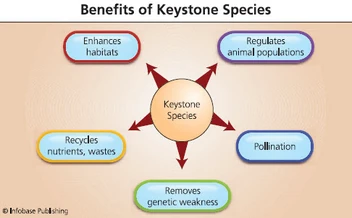
Keystone Species and Their Role in Ecosystems
Keystone Species and Their Role in Ecosystems

5 benefits of keystone species
Keystone species maintain the integrity and stability of the community (Bond, 1993). Removal of a keystone species can result in the loss of other species within the community (Bond, 1993). Keystone species are not limited to the most common species in the community but can be rare and also have a variety of dietary habits (i.e. specialists vs. generalists) (Bond, 1993).
Redefining the term[]
The idea of keystone species has been somewhat controversial as it seems to become overused in the field of conservation science. Paine’s (1995) article provides an interesting discussion on the redefining of the term “keystone species.”
There are many species that act as a keystone or "indicator" species such as the walrus. Walrus statuses are good “indicators of the health of the arctic marine ecosystem” explains Gilbert, of the vital necessity for his aerial census project (1989). If the walrus population is threatened, than it is likely that species of the same ecosystem will also be impacted negatively.
Gilbert, J. (1989). Aerial census of pacific walruses in the Chukchi Sea, 1985. Marine Mammal Science, 5(1), 17-28.
References[]
Bond, W. J. (1993). Keystone species. In Biodiversity and ecosystem function (pp. 237-253). Springer Berlin Heidelberg.
Paine, R. T. (1995). A conversation on refining the concept of keystone species.
Retrieved on November 30, 2013 from www.jstor.org.proxy.lib.muohio.edu/stable/2387008.